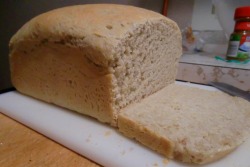I seem to really like making bread recently. After my failed sourdough recipe, I scoured the internet looking for a different recipe to sustain my pour student life style. The internet literally has billions of different bread recipes. This makes sense, because first of all, it's the internet, and secondly, bread is virtually a universal food. For millenia is has been known as "the Staff of Life." This energy dense substance can be made from very few ingredients, flour of any sort, water, oil, and some sort of leavening agent is optional. The French have their Baguettes, Indians have Paratha, Kenyans have Maandazi, and we Americans have good ol' wonder bread. This past week I've been making white bread with variable success. The first loaf I made rose beautifully. The subsequent loaves have had, well, let's just say they've had issues. Whether it was not rising enough, being too fragile, or going stale in 2 days, none of loaves I have made since the first one have been quite as beautiful. I still need to do a little research on bread and yeast, and that post will be to come, but let's talk about the culture of American bread.
What's more American than PB&J on white bread? We all had it packed away in our lunch boxes at some point during elementary school. Some of us, like me, continued to eat it throughout secondary and post secondary education. While today white bread is a staple food across classes, this was not always the case. When milling grain to become flour for white bread, the outer shell (bran) and kernel (germ) are removed leaving only the carbohydrate rich and nutrient deficient endosperm. Whole wheat on the other hand uses the entire grain which is why it has more fiber (from the bran) and vitamin E, Vitamin B12 and fat (from the germ). Ancient Egyptians made it a punishable crime to adulterate the flour to make white bread. During the Middle Ages, those who had money would strip their wheat and make soft, pale white bread. Those who could not afford to waste any part of the wheat made a darker, heartier whole wheat bread. Now, after discovering the health benefits of fiber lost during the milling process of white bread, whole wheat bread has once again become en vogue.
The modern milling process perfected during the industrial revolution in the late 1800s virtually strips white bread of any nutritional value. This was a problem during the Great Depression where the majority of the population survived on white flour products (like white bread). Enter WonderBread.
WonderBread is made with enriched flour which contains synthesized versions of many of the nutrients lost during the milling process. This includes niacin, thiamine, riboflavin, iron, some B vitamins, and calcium, lots and lots of calcium. Incidentally, along with being good for your bones and teeth, it also extends the shelf life of bread. I won't say that WonderBread saved the United States during the Depression, but enriched flour sure did help Americans in need take in some essential vitamins and minerals while getting their daily dose of carbohydrates. It might have been the best thing since sliced bread (which incidentally was a WonderBread creation in 1928)!
Today, WonderBread and many other companies continue to make adulterated white bread. It's cheap, and it's yummy. So go on America, keep on eating an American classic. Just make sure you get all your vitamins and minerals too.
White Bread
Ingredients
2 cups warm water (110 degrees F/45 degrees C)
1/3 cup white sugar
1 ½ tablespoons active dry yeast
1 ½ teaspoons salt
¼ cup vegetable oil
6 cups bread flour
Directions
In a large bowl, dissolve the sugar in warm water, and then stir in
yeast. Allow to proof until yeast resembles a creamy foam.
Mix salt and oil into the yeast. Mix in flour one cup at a time. Knead
dough on a lightly floured surface until smooth. Place in a well oiled
bowl, and turn dough to coat. Cover with a damp cloth. Allow to rise
until doubled in bulk, about 1 hour.
Punch dough down. Knead for a few minutes, and divide in half. Shape
into loaves, and place into two well oiled 9x5 inch loaf pans. Allow
to rise for 30 minutes, or until dough has risen 1 inch above pans.
Bake at 350 degrees F (175 degrees C) for 30 minutes.
What's more American than PB&J on white bread? We all had it packed away in our lunch boxes at some point during elementary school. Some of us, like me, continued to eat it throughout secondary and post secondary education. While today white bread is a staple food across classes, this was not always the case. When milling grain to become flour for white bread, the outer shell (bran) and kernel (germ) are removed leaving only the carbohydrate rich and nutrient deficient endosperm. Whole wheat on the other hand uses the entire grain which is why it has more fiber (from the bran) and vitamin E, Vitamin B12 and fat (from the germ). Ancient Egyptians made it a punishable crime to adulterate the flour to make white bread. During the Middle Ages, those who had money would strip their wheat and make soft, pale white bread. Those who could not afford to waste any part of the wheat made a darker, heartier whole wheat bread. Now, after discovering the health benefits of fiber lost during the milling process of white bread, whole wheat bread has once again become en vogue.
The modern milling process perfected during the industrial revolution in the late 1800s virtually strips white bread of any nutritional value. This was a problem during the Great Depression where the majority of the population survived on white flour products (like white bread). Enter WonderBread.
WonderBread is made with enriched flour which contains synthesized versions of many of the nutrients lost during the milling process. This includes niacin, thiamine, riboflavin, iron, some B vitamins, and calcium, lots and lots of calcium. Incidentally, along with being good for your bones and teeth, it also extends the shelf life of bread. I won't say that WonderBread saved the United States during the Depression, but enriched flour sure did help Americans in need take in some essential vitamins and minerals while getting their daily dose of carbohydrates. It might have been the best thing since sliced bread (which incidentally was a WonderBread creation in 1928)!
Today, WonderBread and many other companies continue to make adulterated white bread. It's cheap, and it's yummy. So go on America, keep on eating an American classic. Just make sure you get all your vitamins and minerals too.
White Bread
Ingredients
2 cups warm water (110 degrees F/45 degrees C)
1/3 cup white sugar
1 ½ tablespoons active dry yeast
1 ½ teaspoons salt
¼ cup vegetable oil
6 cups bread flour
Directions
In a large bowl, dissolve the sugar in warm water, and then stir in
yeast. Allow to proof until yeast resembles a creamy foam.
Mix salt and oil into the yeast. Mix in flour one cup at a time. Knead
dough on a lightly floured surface until smooth. Place in a well oiled
bowl, and turn dough to coat. Cover with a damp cloth. Allow to rise
until doubled in bulk, about 1 hour.
Punch dough down. Knead for a few minutes, and divide in half. Shape
into loaves, and place into two well oiled 9x5 inch loaf pans. Allow
to rise for 30 minutes, or until dough has risen 1 inch above pans.
Bake at 350 degrees F (175 degrees C) for 30 minutes.



